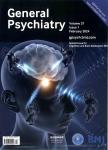Efficacy and safety of repetitive transcranial magnetic stimulation for generalised anxiety disorder: A metaanalysis
作者机构:Shanghai Key Laboratory of Psychotic DisordersShanghai Mental Health CenterShanghai Jiao Tong University School of MedicineShanghaiChina School of governmentShanghai University of Political Science and LawShanghaiChina Institute of Psychology and Behavioral ScienceShanghai Jiao Tong UniversityShanghaiChina Center for Excellence in Brain Science and Intelligence Technology(CEBSIT)Chinese Academy of ScienceShanghaiChina Brain Science and Technology Research CenterShanghai Jiao Tong UniversityShanghaiChina
出 版 物:《General Psychiatry》 (综合精神医学(英文))
年 卷 期:2019年第32卷第5期
页 面:237-248页
核心收录:
学科分类:0402[教育学-心理学(可授教育学、理学学位)] 1004[医学-公共卫生与预防医学(可授医学、理学学位)] 1002[医学-临床医学] 1001[医学-基础医学(可授医学、理学学位)] 10[医学] 1009[医学-特种医学]
基 金:Shanghai Science and Technology Committee(18411952400,19411968600,16411965000) Shanghai Municipal Natural Science Foundation(18ZR1432600) Shanghai Municipal Commission of Health and Family Planning Foundation(20164Y0215,20174Y0021) SHSMU-ION Research Centre for Brain Disorders(2015NKX004).
主 题:stimulation treatment magnetic
摘 要:Background Pharmacological and conventional nonpharmacological treatments are only moderately effective in treatingeneralised anxiety disorder(GAD).Recently,repetitive transcranial magnetic stimulation(rTMS)has attracted interest because of its potential therapeutic value.Aim To investigate the efficacy and safety of rTMS treatment for GAD.Methods Literature studies published in English or Chinese were screened in 10 electronic databases up to 5 December 2018.The included studies bias risk was assessed using Cochrane risk of bias assessment tool.Meta-analysis was performed to compute the standardised mean difference(SMD)and risk ratio(RR)along with its 95%Cis through using RevMan V.5.3.Heterogeneity was inspected by I2 and the χ2 test.We performed subgroup analysis and meta-regression to investigate heterogeneity.We used funnel plot to assess publication bias.We used the GRADE approach to assess the whole quality of evidence.Results Twenty-one studies,with a total sample size of 1481,were analysed.The risk of bias in most studies included is moderate,the majority of which are lacking of blinding methods of treatment allocation.The treatment had beneficial effects in the rTMS group compared with the control group in mean anxiety score(SMD=-0.68;95%Cl-0.89 to-0.46).None of the 21 studies included here reported severe adverse events.As for dropout rates,there are no statistically significant differences between the two groups(RR 1.14,95%Cl 0.72 to 1.82)or adverse events(RR 0.95,95%Cl 0.77 to 1.18).No particular influence on the heterogeneity of any variable was observed.The risk of publication bias was low.According to the GRADE approach,the evidence levels of primary outcome(treatment effects)and secondary outcomes(acceptability and safety)were rated as‘medium’.Conclusion The use of rTMS combined with medication treatment may have a significant positive anti-anxiety effect on patients with GAD.However,we should interpret the results cautiously due to the relatively high heterogeneity of the meta-analysis.Future high-quality clinical trials are needed to confirm our results.



